小升初英语培训课教案
- 格式:doc
- 大小:80.00 KB
- 文档页数:5
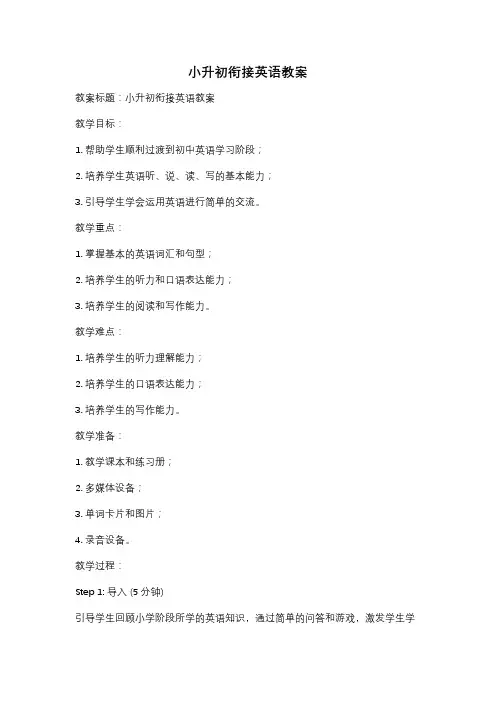
小升初衔接英语教案教案标题:小升初衔接英语教案教学目标:1. 帮助学生顺利过渡到初中英语学习阶段;2. 培养学生英语听、说、读、写的基本能力;3. 引导学生学会运用英语进行简单的交流。
教学重点:1. 掌握基本的英语词汇和句型;2. 培养学生的听力和口语表达能力;3. 培养学生的阅读和写作能力。
教学难点:1. 培养学生的听力理解能力;2. 培养学生的口语表达能力;3. 培养学生的写作能力。
教学准备:1. 教学课本和练习册;2. 多媒体设备;3. 单词卡片和图片;4. 录音设备。
教学过程:Step 1: 导入 (5分钟)引导学生回顾小学阶段所学的英语知识,通过简单的问答和游戏,激发学生学习英语的兴趣。
Step 2: 听力训练 (15分钟)播放一段简短的英语对话,让学生通过听力理解来回答问题。
教师可以提供一些关键词汇,帮助学生更好地理解对话内容。
Step 3: 口语练习 (15分钟)教师出示图片或使用多媒体设备展示相关场景,引导学生进行口语练习。
教师可以提供一些简单的句型和问题,让学生进行对话练习。
Step 4: 阅读训练 (15分钟)教师选择一篇适合学生水平的短文,让学生进行默读,然后回答相关问题。
教师可以提供一些关键词汇和问题,帮助学生更好地理解文章内容。
Step 5: 写作训练 (15分钟)教师给学生提供一个简单的写作题目,例如描述自己的家庭、周末活动等。
学生根据提示进行写作,并互相交换作文进行修改和评价。
Step 6: 温故知新 (10分钟)教师总结本节课所学的重点内容,并进行复习和巩固。
教师可以设计一些小游戏或问答环节,让学生积极参与。
Step 7: 课堂作业 (5分钟)教师布置适当的课堂作业,巩固学生所学的知识点。
作业可以包括完成练习册的相关练习、背诵短文等。
教学反思:通过本节课的教学,学生能够在听、说、读、写等方面得到全面的训练,为他们顺利过渡到初中英语学习阶段打下基础。
教师需要根据学生的实际情况和学校的要求进行适当的调整和补充,确保教学效果的最大化。
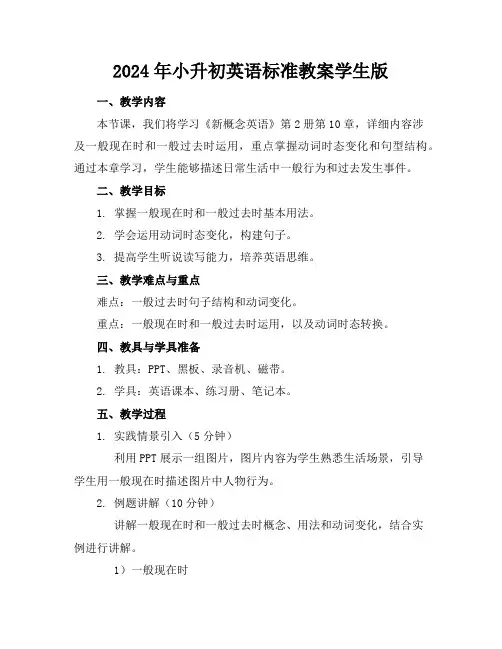
2024年小升初英语标准教案学生版一、教学内容本节课,我们将学习《新概念英语》第2册第10章,详细内容涉及一般现在时和一般过去时运用,重点掌握动词时态变化和句型结构。
通过本章学习,学生能够描述日常生活中一般行为和过去发生事件。
二、教学目标1. 掌握一般现在时和一般过去时基本用法。
2. 学会运用动词时态变化,构建句子。
3. 提高学生听说读写能力,培养英语思维。
三、教学难点与重点难点:一般过去时句子结构和动词变化。
重点:一般现在时和一般过去时运用,以及动词时态转换。
四、教具与学具准备1. 教具:PPT、黑板、录音机、磁带。
2. 学具:英语课本、练习册、笔记本。
五、教学过程1. 实践情景引入(5分钟)利用PPT展示一组图片,图片内容为学生熟悉生活场景,引导学生用一般现在时描述图片中人物行为。
2. 例题讲解(10分钟)讲解一般现在时和一般过去时概念、用法和动词变化,结合实例进行讲解。
1)一般现在时e.g. I get up at 7:00 every day.2)一般过去时e.g. I visited my grandparents last weekend.3. 随堂练习(10分钟)学生根据所学知识,完成练习册上相关练习,巩固一般现在时和一般过去时用法。
4. 小组讨论(15分钟)学生分组,用一般现在时和一般过去时描述组内成员日常行为和过去经历,提高口语表达能力。
5. 课堂小结(5分钟)六、板书设计1. 一般现在时句子结构:主语 + 动词原形/动词三单形式 + 其他2. 一般过去时句子结构:主语 + 动词过去式 + 其他七、作业设计1. 作业题目:1)根据下列词组,用一般现在时和一般过去时造句。
e.g. go to school, play football, visit the zoo, read a book2)翻译下列句子,注意动词时态运用。
e.g. 我昨天去公园。
(I went to the park yesterday.)2. 答案:1)一般现在时:e.g. I go to school every day.He plays football with his friends every weekend.一般过去时:e.g. I visited the zoo last week.She read a book yesterday.2)一般过去时:e.g. I went to the park yesterday.八、课后反思及拓展延伸1. 反思:本节课学生掌握一般现在时和一般过去时基本用法,但部分学生在动词时态变化方面仍存在困难,需要加强练习。
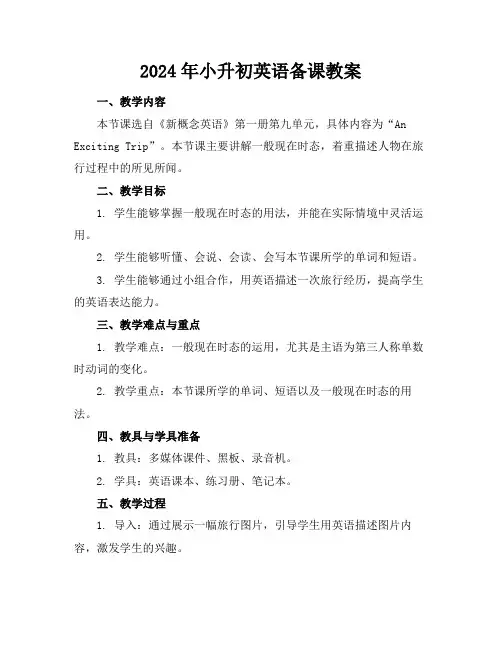
2024年小升初英语备课教案一、教学内容本节课选自《新概念英语》第一册第九单元,具体内容为“An Exciting Trip”。
本节课主要讲解一般现在时态,着重描述人物在旅行过程中的所见所闻。
二、教学目标1. 学生能够掌握一般现在时态的用法,并能在实际情境中灵活运用。
2. 学生能够听懂、会说、会读、会写本节课所学的单词和短语。
3. 学生能够通过小组合作,用英语描述一次旅行经历,提高学生的英语表达能力。
三、教学难点与重点1. 教学难点:一般现在时态的运用,尤其是主语为第三人称单数时动词的变化。
2. 教学重点:本节课所学的单词、短语以及一般现在时态的用法。
四、教具与学具准备1. 教具:多媒体课件、黑板、录音机。
2. 学具:英语课本、练习册、笔记本。
五、教学过程1. 导入:通过展示一幅旅行图片,引导学生用英语描述图片内容,激发学生的兴趣。
2. 新课内容展示:教师讲解一般现在时态的用法,引导学生关注第三人称单数动词变化。
3. 例题讲解:教师呈现例题,讲解解题思路,指导学生完成练习。
4. 随堂练习:学生独立完成练习,教师进行个别辅导。
5. 小组合作:学生分组,用英语描述一次旅行经历,互相交流,提高表达能力。
六、板书设计1. An Exciting Trip2. 重点单词和短语:travel, visit, see, do, like, always, usually, often, sometimes, never等。
3. 一般现在时态:主语 + 动词原形(第三人称单数主语 + 动词三单形式)七、作业设计1. 作业题目:(1)用一般现在时态写一段话,描述你最喜欢的一项运动。
(2)根据所给图片,编写一段旅行经历。
答案:(1)I like playing basketball. I always play it with my friends after school.(2)Last summer, I visited Beijing. I saw the Great Wall and the Forbidden City. I also tried Beijing roasted duck. It was delicious.八、课后反思及拓展延伸1. 课后反思:关注学生在课堂上的参与度,针对学生的疑问进行个别辅导,提高教学效果。
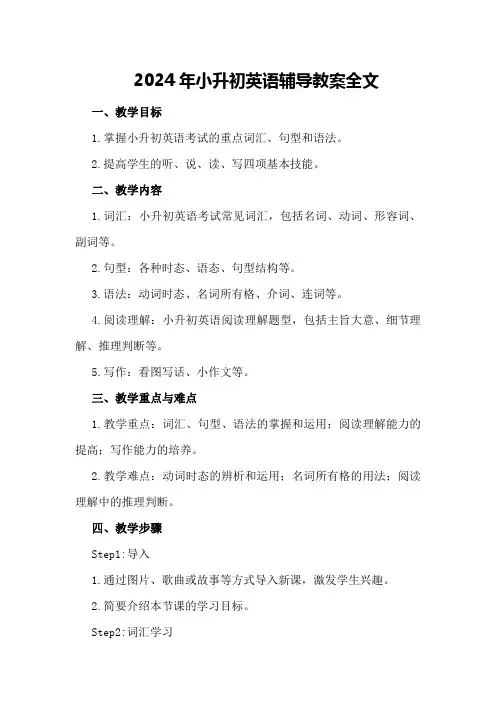
2024年小升初英语辅导教案全文一、教学目标1.掌握小升初英语考试的重点词汇、句型和语法。
2.提高学生的听、说、读、写四项基本技能。
二、教学内容1.词汇:小升初英语考试常见词汇,包括名词、动词、形容词、副词等。
2.句型:各种时态、语态、句型结构等。
3.语法:动词时态、名词所有格、介词、连词等。
4.阅读理解:小升初英语阅读理解题型,包括主旨大意、细节理解、推理判断等。
5.写作:看图写话、小作文等。
三、教学重点与难点1.教学重点:词汇、句型、语法的掌握和运用;阅读理解能力的提高;写作能力的培养。
2.教学难点:动词时态的辨析和运用;名词所有格的用法;阅读理解中的推理判断。
四、教学步骤Step1:导入1.通过图片、歌曲或故事等方式导入新课,激发学生兴趣。
2.简要介绍本节课的学习目标。
Step2:词汇学习1.呈现词汇,让学生跟读、模仿。
2.解释词汇含义,举例说明用法。
3.设计练习,让学生在句子中运用所学词汇。
Step3:句型和语法学习1.呈现句型,让学生跟读、模仿。
2.解释句型结构和语法规则。
3.设计练习,让学生在句子中运用所学句型和语法。
Step4:阅读理解训练1.呈现阅读材料,让学生自主阅读。
2.提出问题,引导学生理解文章主旨和细节。
3.分析问题,帮助学生掌握解题技巧。
Step5:写作训练1.呈现写作题目,让学生思考并讨论。
2.指导写作步骤,如构思、草稿、修改等。
3.分析优秀作文,让学生学习借鉴。
Step6:课堂小结1.回顾本节课所学内容,巩固知识点。
2.鼓励学生提出问题,解答疑惑。
3.布置作业,让学生课后复习。
五、教学评价1.课堂表现:观察学生在课堂上的参与程度、发言积极性和学习态度。
2.作业完成情况:检查学生作业的完成质量和改正情况。
3.测试成绩:定期进行测试,了解学生的学习进度和掌握程度。
案例一:词汇教学1.教学内容:名词、动词、形容词、副词等词汇。
2.教学方法:利用图片、实物、动作等引导学生理解词汇,设计练习让学生在句子中运用所学词汇。
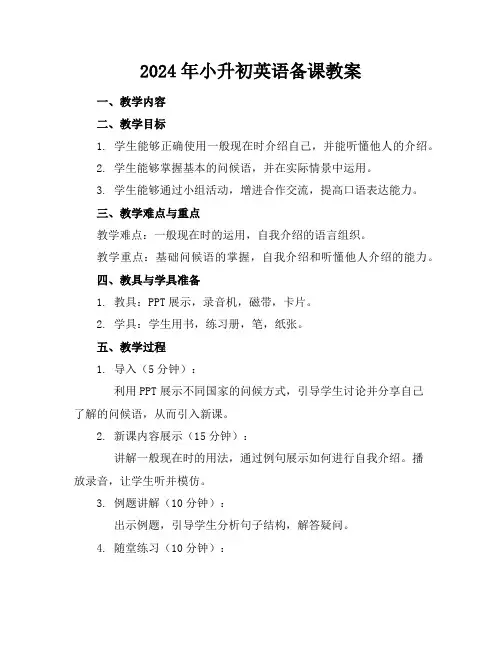
2024年小升初英语备课教案一、教学内容二、教学目标1. 学生能够正确使用一般现在时介绍自己,并能听懂他人的介绍。
2. 学生能够掌握基本的问候语,并在实际情景中运用。
3. 学生能够通过小组活动,增进合作交流,提高口语表达能力。
三、教学难点与重点教学难点:一般现在时的运用,自我介绍的语言组织。
教学重点:基础问候语的掌握,自我介绍和听懂他人介绍的能力。
四、教具与学具准备1. 教具:PPT展示,录音机,磁带,卡片。
2. 学具:学生用书,练习册,笔,纸张。
五、教学过程1. 导入(5分钟):利用PPT展示不同国家的问候方式,引导学生讨论并分享自己了解的问候语,从而引入新课。
2. 新课内容展示(15分钟):讲解一般现在时的用法,通过例句展示如何进行自我介绍。
播放录音,让学生听并模仿。
3. 例题讲解(10分钟):出示例题,引导学生分析句子结构,解答疑问。
4. 随堂练习(10分钟):学生两人一组,互相介绍自己,并进行角色扮演,模拟认识新朋友。
5. 小组活动(15分钟):学生分组进行口语练习,互相介绍,要求每人至少介绍一位组员。
教师选取几名学生展示成果,并对学生的表现给予评价。
六、板书设计1. My name is Tom.2. 内容:一般现在时结构:主语 + 动词原形常用问候语:Hello!/Hi!/How do you do?七、作业设计1. 作业题目:根据课堂所学,用一般现在时介绍自己的家庭,不少于50词。
2. 答案示例:八、课后反思及拓展延伸1. 课后反思:通过本节课的学习,学生能够基本掌握自我介绍和问候他人的表达方式,但部分学生在口语表达时仍存在紧张、不自信的现象,需要在今后的教学中加强口语练习,提高学生的自信心。
2. 拓展延伸:布置课后作业,让学生用一般现在时介绍自己的朋友或同学,增强语言运用能力。
同时,鼓励学生在生活中用英语进行交流,提高实际运用能力。
重点和难点解析1. 教学难点:一般现在时的运用,自我介绍的语言组织。
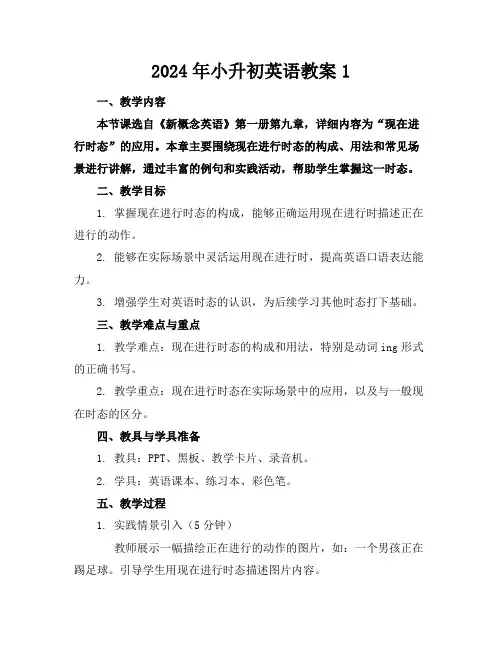
2024年小升初英语教案1一、教学内容本节课选自《新概念英语》第一册第九章,详细内容为“现在进行时态”的应用。
本章主要围绕现在进行时态的构成、用法和常见场景进行讲解,通过丰富的例句和实践活动,帮助学生掌握这一时态。
二、教学目标1. 掌握现在进行时态的构成,能够正确运用现在进行时描述正在进行的动作。
2. 能够在实际场景中灵活运用现在进行时,提高英语口语表达能力。
3. 增强学生对英语时态的认识,为后续学习其他时态打下基础。
三、教学难点与重点1. 教学难点:现在进行时态的构成和用法,特别是动词ing形式的正确书写。
2. 教学重点:现在进行时态在实际场景中的应用,以及与一般现在时态的区分。
四、教具与学具准备1. 教具:PPT、黑板、教学卡片、录音机。
2. 学具:英语课本、练习本、彩色笔。
五、教学过程1. 实践情景引入(5分钟)教师展示一幅描绘正在进行的动作的图片,如:一个男孩正在踢足球。
引导学生用现在进行时态描述图片内容。
2. 例题讲解(10分钟)教师通过PPT展示例题,讲解现在进行时态的构成和用法,引导学生正确书写动词ing形式。
3. 随堂练习(10分钟)学生根据教师提供的场景,用现在进行时态造句。
教师点评并纠正错误。
4. 小组活动(15分钟)学生分组,每组设计一个场景,用现在进行时态进行角色扮演。
其他小组观摩并给出评价。
5. 录音机播放(5分钟)教师播放一段英语对话,学生听录音并回答问题,巩固现在进行时态的应用。
六、板书设计1. 现在进行时态2. 内容:现在进行时态的构成:主语 + be动词(am/is/are) + 动词ing常见场景:正在进行的动作、正在发生的事情等。
七、作业设计1. 作业题目:(2) 根据所给句子,改写为现在进行时态:I eat an apple.→ I am eating an apple.2. 答案:(1) The girl is drawing a picture. Two boys areplaying basketball.(2) I am eating an apple.八、课后反思及拓展延伸1. 课后反思:教师针对本节课的教学效果进行反思,了解学生对现在进行时态的掌握程度,调整教学方法。
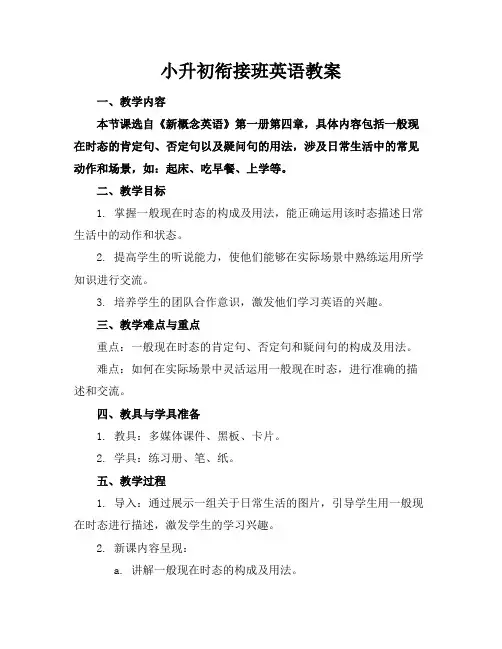
小升初衔接班英语教案一、教学内容本节课选自《新概念英语》第一册第四章,具体内容包括一般现在时态的肯定句、否定句以及疑问句的用法,涉及日常生活中的常见动作和场景,如:起床、吃早餐、上学等。
二、教学目标1. 掌握一般现在时态的构成及用法,能正确运用该时态描述日常生活中的动作和状态。
2. 提高学生的听说能力,使他们能够在实际场景中熟练运用所学知识进行交流。
3. 培养学生的团队合作意识,激发他们学习英语的兴趣。
三、教学难点与重点重点:一般现在时态的肯定句、否定句和疑问句的构成及用法。
难点:如何在实际场景中灵活运用一般现在时态,进行准确的描述和交流。
四、教具与学具准备1. 教具:多媒体课件、黑板、卡片。
2. 学具:练习册、笔、纸。
五、教学过程1. 导入:通过展示一组关于日常生活的图片,引导学生用一般现在时态进行描述,激发学生的学习兴趣。
2. 新课内容呈现:a. 讲解一般现在时态的构成及用法。
b. 通过例句和场景,让学生感知并运用一般现在时态。
3. 例题讲解:针对一般现在时态的肯定句、否定句和疑问句进行讲解,让学生掌握其结构和用法。
4. 随堂练习:让学生进行小组讨论,用一般现在时态描述组内成员的日常活动,并进行展示。
六、板书设计1. 一般现在时态的肯定句、否定句和疑问句结构。
2. 常用动词的原形、三单形式及过去式。
3. 课堂重点词汇和句子。
七、作业设计a. 我每天早上7点起床。
b. 他们通常在食堂吃午饭。
c. 我们每周五下午有英语课。
答案:a. I get up at 7 o'clock every morning.b. They usually have lunch in the cafeteria.c. We have English class every Friday afternoon.2. 课后作业:完成练习册上关于一般现在时态的练习。
八、课后反思及拓展延伸1. 反思:关注学生在课堂上的表现,了解他们对一般现在时态的掌握情况,针对问题进行个别辅导。
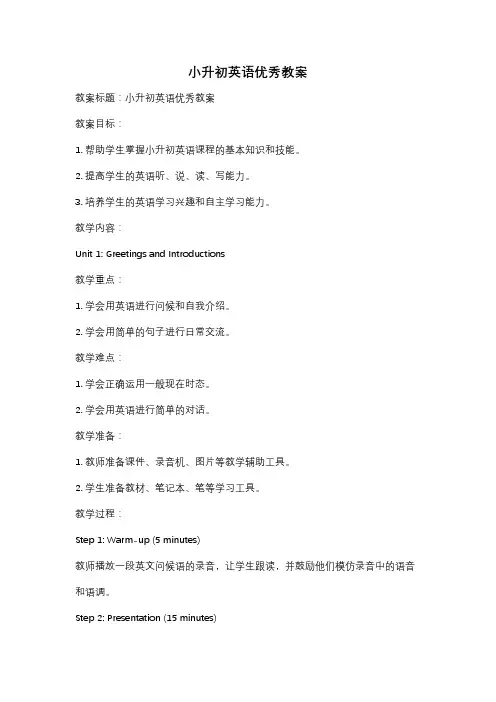
小升初英语优秀教案教案标题:小升初英语优秀教案教案目标:1. 帮助学生掌握小升初英语课程的基本知识和技能。
2. 提高学生的英语听、说、读、写能力。
3. 培养学生的英语学习兴趣和自主学习能力。
教学内容:Unit 1: Greetings and Introductions教学重点:1. 学会用英语进行问候和自我介绍。
2. 学会用简单的句子进行日常交流。
教学难点:1. 学会正确运用一般现在时态。
2. 学会用英语进行简单的对话。
教学准备:1. 教师准备课件、录音机、图片等教学辅助工具。
2. 学生准备教材、笔记本、笔等学习工具。
教学过程:Step 1: Warm-up (5 minutes)教师播放一段英文问候语的录音,让学生跟读,并鼓励他们模仿录音中的语音和语调。
Step 2: Presentation (15 minutes)教师通过图片和实物展示问候语和自我介绍的表达方式,并逐句解释其含义和用法。
然后,教师播放录音示范正确的发音和语调。
Step 3: Practice (20 minutes)教师分组让学生进行角色扮演,练习问候和自我介绍的对话。
教师可以提供一些问题和回答的模板,帮助学生更好地理解和运用。
Step 4: Consolidation (10 minutes)教师设计一些练习题,让学生巩固所学内容。
例如,填空题、选择题等。
教师可以通过抽查学生回答问题的方式来检查学生的掌握情况。
Step 5: Extension (10 minutes)教师设计一些拓展活动,如唱英文歌曲、玩英语游戏等,以激发学生的学习兴趣和提高学习动力。
Step 6: Summary and Homework (5 minutes)教师对本节课的重点内容进行总结,并布置相应的作业,如写一篇简短的英文自我介绍。
教学评价:教师可以通过观察学生的表现、听力练习的成绩、课堂练习的答题情况等方式进行评价。
同时,教师还可以收集学生的作业,对其写作能力进行评估。
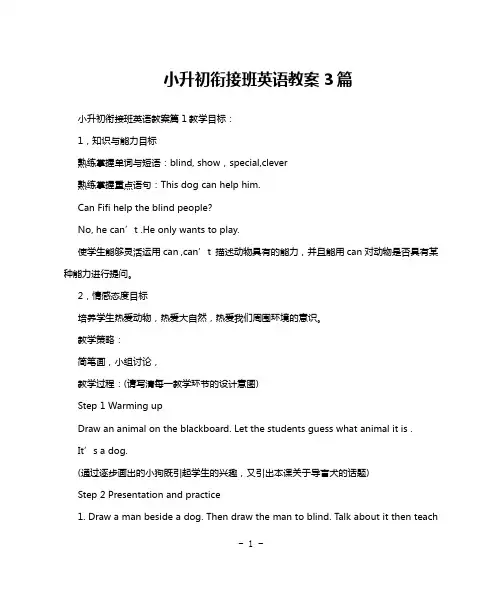
小升初衔接班英语教案3篇小升初衔接班英语教案篇1教学目标:1,知识与能力目标熟练掌握单词与短语:blind, show,special,clever熟练掌握重点语句:This dog can help him.Can Fifi help the blind people?No, he can’t .He only wants to play.使学生能够灵活运用can ,can’t 描述动物具有的能力,并且能用can对动物是否具有某种能力进行提问。
2,情感态度目标培养学生热爱动物,热爱大自然,热爱我们周围环境的意识。
教学策略:简笔画,小组讨论,教学过程:(请写清每一教学环节的设计意图)Step 1 Warming upDraw an animal on the blackboard. Let the students guess what animal it is .It’s a dog.(通过逐步画出的小狗既引起学生的兴趣,又引出本课关于导盲犬的话题)Step 2 Presentation and practice1. Draw a man beside a dog. Then draw the man to blind. Talk about it then teachthe word“blind”.Watch a TV show and answer a question“Who can help the blind man ?”2. Listen to the passage and repeat it. Try to be the TV presenter.1)跟读一遍刚刚观看过的盲人与导盲犬的电视节目的文章。
2)请学生试读缺少个别词语的文章。
3)小组练习,根据每句提示词试复述文章。
3.Listen to CDROM and answer the question “Can Fifi help the blind people? ”Write down the sentence on the blackboard and repeat it.4.Listen again and answer the question “What does he want to do?”5. Listen and circle the sentences with “can or can’t”.6. Memorizing game. Guess what the special animals can do .7. Listen the passage and repeat it.8. Do some exercises on AB p26 1: Read the text and circle.(通过听读和练习使学生对课文有基本的掌握,并能基本流利朗读、初步记忆)Step 4 Consolidation and extension1. Talk about pictures about some special animals. Then the students talk about them in group using "This…can … . This …can’t … . "3. Give each group a picture of an animal, let each group watch and discuss. For example, “It’s white. It’s fat. It can catch the mouse. It can’t swim.”Then show it.(通过练习使学生既掌握住can和can’t的用法并复习形容词的用法,又学会对动物能力的描述)Step 5 Summary1,引导学生自主回顾本节课所学知识,引导学生发现生活中动物对人类的帮助,培养学生热爱动物,热爱大自然的意识。
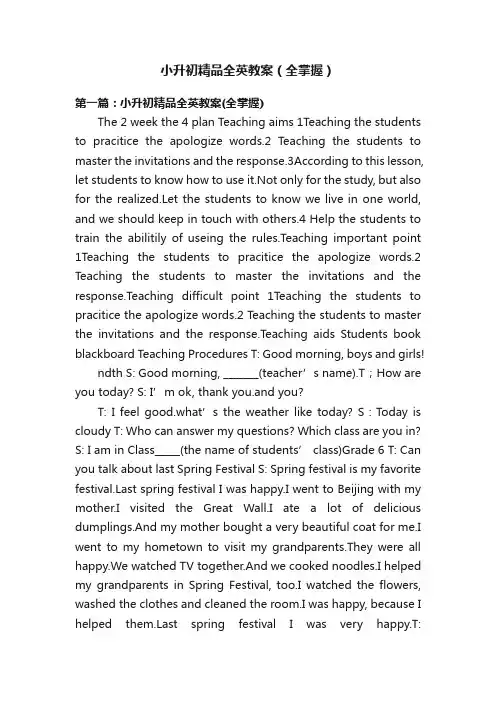
小升初精品全英教案(全掌握)第一篇:小升初精品全英教案(全掌握)The 2 week the 4 plan Teaching aims 1Teaching the students to pracitice the apologize words.2 Teaching the students to master the invitations and the response.3According to this lesson, let students to know how to use it.Not only for the study, but also for the realized.Let the students to know we live in one world, and we should keep in touch with others.4 Help the students to train the abilitily of useing the rules.Teaching important point 1Teaching the students to pracitice the apologize words.2 Teaching the students to master the invitations and the response.Teaching difficult point 1Teaching the students to pracitice the apologize words.2 Teaching the students to master the invitations and the response.Teaching aids Students book blackboard Teaching Procedures T: Good morning, boys and girls!ndth S: Good morning, _______(teacher’s name).T;How are you today? S: I’m ok, thank you.and you?T: I feel go od.what’s the weather like today? S:Today is cloudy T: Who can answer my questions? Which class are you in? S: I am in Class_____(the name of students’ class)Grade 6 T: Can you talk about last Spring Festival S: Spring festival is my favorite st spring festival I was happy.I went to Beijing with my mother.I visited the Great Wall.I ate a lot of delicious dumplings.And my mother bought a very beautiful coat for me.I went to my hometown to visit my grandparents.They were all happy.We watched TV together.And we cooked noodles.I helped my grandparents in Spring Festival, too.I watched the flowers, washed the clothes and cleaned the room.I was happy, because I helped st spring festival I was very happy.T:Thanks.ok.Today’s English sentence is “Once bitten, twice shy!”(The first teacher show the sentence“Once bitten, twice shy!” on the blackboard.And teacher teaches the students to read 3 times.And teacher can find 2-3 students to read the sentence.Then teacher tells the meaning of the sentence.Then teacher needs to give students an example.)Step 2Revision 1 let the students have a dictation.T: Please take out your dictation book, I will deictic the words of vocabulary of O.(Find a student to read the sentences of PEP, and then other students follow him to read it.)2 Review the English sentence we learnt last lesson.Ask the students to say it T:Yester day we learnd the reponce about apologies.If I say sorry,who can give the sentences to answer it, at least you must say four: S:It does’t matter.S:That’ all right.S:Never mind.S: That’s Ok(Show the pictures of meaning about the lesson we learned last lesson and find the partners to make a dialogue.The winner can get a point.)Step 3New lessons 1 Teacher asks some question about invitation T: Who can tell me What is an invitation? And who knows the information in an invitation? 2 If the students don’t know it,then tell them that invitation is way to invite someone to do something or help you to do something.Either kind of invitation must do three things: Invite the reader to the gathering.Offer a reason for the gathering.Give the date, time, and place of the gathering.Often formal invitations include“RSVP”and a telephone number.The RSVP notation means“Please let us know if you plan to attend.”It informs invited guests that the host is expecting an immediate telephone reply to facilitate plans for the event.If an invitation includes“Regrets only”,it will require a reply only if the invited guest cannot attend. 4 Ask the sudentesto look at the PPT, , tell them the day after tomorrow will be Amy’s birthday party, Amy want to invite Zhang Peng , what would she say? S: The day after tomorrow will be my birthday party, can you come to my birthdat party? T: Yes, we can say that.But if you want invite someone to do something, you’d better not use this sentence.We can say “Would you like to my birthday party”, this sentence is more politly than that one.(When we use “would”, it means we want someone agree with me or do something.And the word “would” always connect with “you”.)5 T: Who can give other sentences about invitation? S: Sorry, I don’t know.T: Ok, Please look at the blackboard, I will write some sentences about invitation.Would you like to come with me? I wonder if you can....Would you mind if I ask you.....? Would you want some coffee? Would you plesae....? Are you free this afternoon? Is it possible that you can...? T:Plesase wirte these sentences on you note book, and then follow me to read it 6 Give the students a conversation, and ask the students according this to make a sentence T: Mike want Jack to watch movie with him,if you are Mike, what would you say? S1:I wonder if you can to the cinema with me? T: Yes, you are right, what else? S2:I’d like to invite you to watch movie.T:Great,who has different opain? S3: Is it possible that you can watch movie with me? T: Wonderful, also we can say that.After then , ask the student to read these sentences Summary This lesson let the student to know how to invite to others, according this lesson, let the students to know we live in one world, and we should keep in touch with others(When we use “would you…?” this word connects with “some…”to tell the meaning that we want someone agree with use.And we can use the word “any”in this question sentence.)Homework 1 Dothe exercise on P114 2Copy the Engliosh sentence we learnt for three times Bb design Either kind of invitation must do three things: Invite the reader to the gathering. Offer a reason for the gathering.Give the date, time, and place of the gathering. Usefel sentences Would you like to come with me? I wonder if you can....Would you mind if I ask you.....? Would you want some coffee? Would you plesae....? Are you free this afternoon? Is it possible that you can...? Reflection第二篇:小升初全英自我介绍!Goodafternoon, teachers and classmeats!Today, I`m very happy to make a speech here.Now, let me introduce myself.My name is ma shou chuan.My English name is sky.I`m 12.I come from Class3 Grade 6 of Zhongsahnlu No.1Primary School.[ˈpraim əri sku:l]My hobby(兴趣)['hɒbi]is verywidespread(.广泛)[ˈwaɪdspred]I like playing ping-pong.Because I think it`s very interesting.And I like to play the flute andcucurbit: [ kju(:)'kəbit ]flute: [ flu:t ]I`d like to eat potatoes.They`re tasty.,I like Chinese calligraphy very much.Becauseshe is Chinese traditional culture.And I like math best.It`s fun.On the weekend or every night, I like reading books in my room.I have a happy family.My father isa teacher.My mother is a teacher too.they are hard-working.And I`m a good student.My dream is to be amathematician[ˈmæθəməˈtɪʃn], becauseI want to make a contribution[ˈkɒntrɪˈbju:ʃn] to mankind.It's my pleasure to study with all of you, I hope that we can help each other and achieving together in the future.I'm willing to be everyone's friend.Thank you for listening!第三篇:初中英语全英教案A teaching plan教材分析学情分析Contents: 1.Vocabulary: 2.Structure: 3.Dialogue: 4.listening: Objectives:1.Teaching Aims and Demands(1)Instructional ObjectivesBe able to use the new words and phrases:(2)Ability Objectives Be able to use listening skills to comprehend their dialogues, such as listen for specific information etc.Be able to use what they learned to describe what they can do and give responses.Be able to use the language they learned to finish a dialogue and a short passage.(3)Educational ObjectivesArousing students’ interest and helping them learn by using pictures.Building their confidence by step by step approach and careful scaffolding.2.Teaching Importance To master the key vocabularyTo understand and use the target language To master the usage of the different forms of “can” in the target language.3.Teaching Difficulties To enable the students to understand the sentence patterns to talk about the ability activities.To enable the students to use the target language The students learned the structure “can do sth”, So it’s difficult and important to let them understand it can also be used to talk about the ability activities.4.Teaching Aids Multi-media computer, Tape recorder and so on.5.The Teaching Methods(1)Communicative teaching method.(2)Audio-visual teaching method.(3)Task-based teaching method.6.Studying Ways(1)Let the Ss pass “Observation—Imitation—Practice” to study language.(2)Let the Ss pay attention to the key information in listening practice.(3)Enable the Ss to study English language by Communication.(4)Let the Ss know that conclusions and being good at thinking are necessary to learn English well.Proceduresand Time Allotment: 2 Task1: Warming-up(2mins)Before class, get Ss to enjoy an English song for about 2 minutes to warm them up.The purpose of the task-based activities is to Interest the students Task 2:Lead-in(3mins)e the PPT to lead in the new lesson..show some pictures and teach the words and phrases: 2.ask Ss read the words together.Task3: Play a game(4mins)Task 4: Presentation(8mins)The purpose of the task-based activities is to let the students learn to cooperate with each other and practice the language points, improve the students’ abilities of speaking.Task5: Representations(5mins)Task 6.Listening(5mins)1.Ask Ss to open their books and turn to Page 59.Look at part 1b, look at the conversations and make sure the students understand the conversations and what to do.Then play the tape for three times.For the first time the students only listen to understand the whole general meaning of the conversations.For the second time the Ss pay attention to the activity in each conversation and write them in the blanks.For the third time the Ss pay attention to the time that the activities in each conversation are done and number the conversations(1-3).Ask some Ss to check their answers.2.Practice the conversations in 1b.Then make your own 3 conversations.The purpose of the task-based activities is to practice listening and improve the students’ abilities of lis tening.Task 7.Make a survey(7mins)Give the students several minutes to prepare the survey using the target language to ask and answer, next fill the form : Finally ask two groups of the students to report their results.For example: Task 8.Summary(4 mins)Summarize the key language points in groups , and show them on the screen to help the Ss take notes.Task 9.Homework(2mins)1.Consolidate and review theexpressions of the lesson.2.Write a short passage about the results of the survey.Blackboard design第四篇:Module1-4全英教案Module1 The Great Wall1、Teaching preparing:Students book:Module1Unit 1Activity1, 2, 32、Teaching task: A.basic object:Key words:thousand postcard more kilometerKey sentences: “These postcards are great!” “It‟s a picture of the Great Wall.”“Tell me more about the Great Wall.”“How long is it?B.To learn “thousandkilometermillion ” C.Review: The using way of the verb …be‟ 2.Talking about some famous places.3、Teaching point: words:thousandkilometermillion postcardmore4、T eaching difficulty:kilometerthousandmillion“Tell me more about the Great Wall.“It‟s a picture of the Great Wall.”5、Task design: words: postcardmorethousandkilometermillionSentences: “These postcards are great!” “It‟s a picture of the Great Wall.”“Tell me more about the Great Wall.”“How long is it?”“It‟s about six thousand seven hundred kilometers.”的句型。

小升初英语辅导教案全文免费教案名称:小升初英语辅导一、教学内容本节课选自《新概念英语》第一册,第7课:The Best and the Worst。
本节课主要讲述了作者和他的朋友们谈论他们最喜欢的季节以及最不喜欢的季节。
主要语言点为:一般现在时态的描述喜好和一般过去时态的描述过去发生的事情。
二、教学目标1. 学生能够听懂、会说、会读本节课的故事内容。
2. 学生能够运用一般现在时态和一般过去时态描述自己的喜好和经历。
3. 学生能够通过本节课的学习,提高自己的英语学习兴趣和积极性。
三、教学难点与重点重点:一般现在时态和一般过去时态的运用。
难点:一般过去时态的动词形式变化。
四、教具与学具准备教具:PPT、黑板、粉笔学具:课本、练习本、文具五、教学过程1. 热身(5分钟)教师与学生用英语进行简单的交流,询问学生喜欢的季节,引导学生用英语进行回答。
2. 引入(10分钟)教师播放本节课的故事音频,让学生边听边跟读。
然后教师提问学生对故事的理解,引导学生用英语进行回答。
3. 新课讲解(20分钟)教师引导学生学习一般现在时态和一般过去时态,并通过PPT展示相应的例子。
然后教师让学生在黑板上写出一般过去时态的动词形式变化,并让学生进行练习。
4. 课堂练习(15分钟)教师给出一些关于季节的图片,让学生用一般现在时态和一般过去时态进行描述。
教师可以个别辅导学生,帮助学生正确运用时态。
六、板书设计板书内容:一般现在时态:我喜欢春天。
一般过去时态:我喜欢去年的春天。
七、作业设计1. 抄写本节课的故事内容,并背诵。
2. 用一般现在时态和一般过去时态分别写一篇关于季节的作文。
八、课后反思及拓展延伸教师对本节课的教学效果进行反思,看是否达到了教学目标,学生是否掌握了时态的运用。
同时,教师可以给学生推荐一些关于季节的英语绘本或文章,让学生课后进行阅读,提高英语水平。
重点和难点解析在小升初英语辅导教案中,有几个重点和难点是需要特别关注的。
小升初英语辅导教案全文免费一、教学内容本教案以《新概念英语》第一册为基础教材,主要涉及第14单元的内容。
详细内容包括:基础语法知识(如动词时态、名词所有格)、常用词汇和短语、日常会话句型等。
二、教学目标1. 让学生掌握基本的英语语法知识,能正确运用动词时态和名词所有格。
2. 扩大学生的词汇量,学会使用常用的词汇和短语进行日常交流。
3. 培养学生的英语听说读写能力,提高他们的英语综合素质。
三、教学难点与重点1. 教学难点:动词时态的运用,名词所有格的使用。
2. 教学重点:常用词汇和短语的学习,日常会话句型的掌握。
四、教具与学具准备1. 教具:PPT,黑板,录音机,磁带。
2. 学具:教材,《新概念英语》第一册,笔记本,练习本。
五、教学过程1. 导入:通过情景剧表演,让学生复习和巩固已学的日常会话句型,激发学习兴趣。
2. 新课内容展示:通过PPT展示动词时态、名词所有格的用法,结合实例进行讲解。
3. 例题讲解:针对新课内容,精选典型例题进行讲解,让学生更好地理解和掌握语法知识。
4. 随堂练习:布置一些练习题,让学生当堂完成,巩固所学知识。
六、板书设计1. 动词时态:一般现在时、一般过去时、一般将来时2. 名词所有格:’s,of3. 常用词汇和短语:如get up,go to school,play sports等。
七、作业设计1. 作业题目:(1)用动词时态改写下列句子:I __________ (eat) breakfast every morning.(2)根据课文内容,用名词所有格填空:This is__________ (Tom and Jerry) house.(3)翻译下列句子:我每天早上7点起床。
__________2. 答案:(1)eat(2)Tom and Jerry’s(3)I get up at 7 o’clock every morning.八、课后反思及拓展延伸1. 课后反思:针对本节课的教学效果,反思教学方法和手段,不断调整和完善教学策略。
小升初英语培训课教案第一章:英语字母表和发音规则1.1 学习26个英文字母的书写和读音1.2 掌握元音字母a, e, i, o, u的发音规则1.3 学习辅音字母的发音规则和常见组合1.4 练习字母表歌曲,巩固记忆第二章:基本语法和句子结构2.1 学习主谓宾结构,举例说明2.2 学习定语和状语的概念及用法2.3 学习名词、动词、形容词、副词的词性辨析2.4 练习编写简单句子,运用所学语法知识第三章:日常口语交流3.1 学习问候语、介绍自己、询问时间等基本口语表达3.2 学习常用疑问词如what, where, who, how等的使用3.3 练习情景对话,提高口语表达能力3.4 学习简单句型转换,如疑问句、否定句等第四章:词汇量和词组搭配4.1 学习生活中常见的动词、名词、形容词等词汇4.2 学习常用词组的搭配,如look forward to, thanks to等4.3 扩充词汇量,学习同义词、反义词4.4 进行词汇游戏,巩固记忆第五章:阅读理解5.1 学习阅读理解的基本技巧,如找关键词、理解主旨等5.2 练习阅读简单的故事或文章,回答相关问题5.3 提高阅读速度和理解能力,进行计时阅读5.4 学习如何写读后感,表达对文章的观点和感受第六章:写作技巧和练习6.1 学习英语写作的基本结构,包括开头、中间和结尾6.2 学习如何进行段落划分,使文章条理清晰6.3 学习使用连接词和过渡语,使文章连贯流畅6.4 练习写作,以日记、故事或议论文形式进行第七章:听力理解和语音辨识7.1 学习听力理解的基本技巧,如预测、猜词义等7.2 练习听取简单的对话和故事,回答相关问题7.3 提高语音辨识能力,学习区分相似音素7.4 观看英语动画或短片,进行听力训练第八章:口语表达和角色扮演8.1 学习如何在不同的情景下进行口语表达,如购物、问路等8.2 学习使用条件句、并列句等复杂句型8.3 进行角色扮演,模拟真实场景,提高口语交际能力8.4 学习如何进行有效的演讲和汇报第九章:语法加强和练习9.1 学习动词时态,如一般现在时、一般过去时、一般将来时等9.2 学习被动语态和主动语态的用法和转换9.3 学习情态动词,如can、may、must等的用法9.4 进行语法练习,巩固所学知识第十章:综合测试和复习10.1 进行全面的听力、阅读、写作和口语测试10.2 复习整个学期的知识点,查漏补缺10.3 分析测试结果,为学生提供反馈和建议重点和难点解析一、英语字母表和发音规则重点:字母表的书写和读音,元音字母的发音规则。
2024年小升初英语教案模板一、教学内容本节课选自《新概念英语》第一册第五章,具体内容包括:一般现在时态的肯定句、否定句以及疑问句;常用动词的第三人称单数形式;以及相关日常对话。
二、教学目标1. 让学生掌握一般现在时态的用法,能够正确运用肯定句、否定句和疑问句。
2. 使学生掌握常用动词的第三人称单数形式。
3. 培养学生运用英语进行日常交流的能力。
三、教学难点与重点教学难点:一般现在时态的疑问句构成,尤其是主语为第三人称单数时。
教学重点:一般现在时态的肯定句、否定句以及疑问句的用法和动词第三人称单数形式。
四、教具与学具准备教具:黑板、粉笔、教学PPT、录音机、磁带。
学具:英语课本、练习本、铅笔。
五、教学过程1. 导入(5分钟)利用PPT展示日常生活场景,引导学生用英语描述图片内容,复习一般现在时态。
2. 讲解(15分钟)(1)讲解一般现在时态的肯定句、否定句和疑问句的构成。
(2)讲解常用动词的第三人称单数形式。
(3)通过例句和场景对话,让学生理解并掌握语法点。
3. 实践(15分钟)(1)进行小组活动,让学生互相提问,练习一般现在时态的疑问句。
(2)分组进行角色扮演,模拟日常生活场景,用英语进行对话。
4. 例题讲解(10分钟)出示典型例题,引导学生分析并解答,巩固所学知识。
5. 随堂练习(10分钟)布置一些一般现在时态的练习题,让学生当堂完成,及时巩固。
六、板书设计1. 一般现在时态的肯定句、否定句和疑问句构成。
2. 常用动词的第三人称单数形式。
3. 日常生活场景对话。
七、作业设计1. 作业题目:(1)完成练习册上的一般现在时态练习题。
(2)用英语写一篇关于自己日常生活的短文。
2. 答案:(1)见练习册答案。
(2)范文:My Daily LifeI get up at 6:00 every morning. After breakfast, I go to school at 7:00. I have four classes in the morning. I have lunch at 12:00. In the afternoon, I have two classes. After school, I do my homework and play sports. I have dinner at6:00. In the evening, I watch TV and read books. I go to bedat 9:00.八、课后反思及拓展延伸1. 课后反思:关注学生在课堂上的学习情况,了解他们对一般现在时态的掌握程度,及时调整教学方法,提高教学效果。
小升初英语培训课教案第一章:英语字母表和发音规则教学目标:1. 让学生掌握英语字母表的26个字母。
2. 让学生了解并掌握英语的基本发音规则。
教学内容:1. 英语字母表的顺序和名称。
2. 英语元音字母和辅音字母的发音规则。
3. 简单单词的拼读练习。
教学活动:1. 字母表游戏:让学生按照字母表的顺序排列字母卡片。
2. 发音规则讲解:通过示例和练习,让学生掌握基本的发音规则。
3. 单词拼读练习:让学生读出给定的单词,并正确拼写。
作业:1. 复习英语字母表,并能够默写。
2. 复习发音规则,并能够运用到单词拼读中。
第二章:基本语法教学目标:1. 让学生了解并掌握英语的基本语法,包括名词、动词、形容词、副词等词性的用法。
教学内容:1. 名词的单复数形式和所有格。
2. 动词的时态和语态。
3. 形容词和副词的比较级和最高级。
教学活动:1. 语法讲解:通过示例和练习,让学生掌握基本语法的用法。
2. 语法练习:让学生运用所学的语法知识完成练习题。
作业:1. 复习所学的语法知识,并能够运用到句子中。
2. 完成语法练习题。
第三章:日常对话教学目标:1. 让学生能够进行简单的日常对话,包括问候、介绍、道别等。
教学内容:1. 日常对话的常用句型和表达方式。
2. 日常对话中的礼貌用语。
教学活动:1. 对话表演:让学生分组进行对话表演,巩固所学的日常用语。
2. 角色扮演:让学生扮演不同角色,进行日常对话练习。
作业:1. 复习所学的日常对话用语,并能够运用到实际情境中。
2. 与同学进行日常对话练习。
第四章:阅读理解教学目标:1. 让学生能够理解简单的英文文章,并能够回答相关问题。
教学内容:1. 阅读理解的基本技巧和策略。
2. 简单文章的阅读和理解。
教学活动:1. 阅读技巧讲解:通过示例和练习,让学生掌握阅读理解的技巧。
2. 阅读练习:让学生阅读给定的文章,并回答相关问题。
作业:1. 复习所学的阅读理解技巧,并能够运用到文章阅读中。
小升初英语培训课教案一、教学目标1. 知识目标:(1)掌握一定的词汇量和基本语法规则;(2)提高听力、口语、阅读和写作能力;(3)了解英语文化背景,培养跨文化交际意识。
2. 能力目标:(1)能够运用所学知识进行日常交流;(2)能够独立完成英语听说读写任务;(3)培养自主学习能力和团队合作精神。
3. 情感目标:(1)激发学习英语的兴趣,增强自信心;(3)提高综合素质,为升入初中做好充分准备。
二、教学内容1. 语音知识:学习字母表、音标、基本语音规则,提高发音准确性。
2. 词汇学习:学习常用单词和短语,加强词汇积累。
3. 语法知识:掌握基本句型和语法规则,提高句子构建能力。
4. 听力训练:通过听力材料,提高听力理解能力,培养英语思维。
5. 口语表达:进行情景对话练习,提高日常口语交流能力。
三、教学方法1. 任务型教学法:通过完成各种实际任务,提高学生的综合语言运用能力。
2. 情境教学法:创设真实的语言环境,激发学生学习兴趣。
3. 游戏教学法:通过趣味游戏,巩固所学知识,提高学习效果。
4. 分组合作学习:培养学生的团队协作能力和自主学习能力。
四、教学评价1. 过程性评价:关注学生在学习过程中的表现,及时给予指导和鼓励。
2. 终结性评价:定期进行测试,检验学生的学习成果。
3. 自我评价:引导学生进行自我反思,提高自我学习能力。
五、教学计划1. 第一周:语音知识学习,字母表、音标、基本语音规则。
2. 第二周:词汇学习,常用单词和短语。
3. 第三周:语法知识学习,基本句型和语法规则。
4. 第四周:听力训练,提高听力理解能力。
5. 第五周:口语表达,情景对话练习。
六、教学计划(续)6. 第六周:综合练习,巩固所学知识,提高综合运用能力。
7. 第七周:英语文化背景学习,了解西方文化,培养跨文化交际意识。
8. 第八周:复习与总结,回顾所学内容,查漏补缺。
9. 第九周:模拟测试,检验学生综合能力,为升入初中做好准备。
小升初英语辅导教案全文免费一、教学内容二、教学目标1. 掌握一般现在时态的构成和用法,能够正确运用该时态描述日常生活习惯和客观事实。
2. 学会动词第三人称单数形式的变换规则,并能熟练应用于实际语境。
3. 能够运用一般现在时态进行简单的交流,提高英语口语表达能力。
三、教学难点与重点1. 教学难点:一般现在时态的疑问句结构变换,尤其是助动词do/does的使用。
2. 教学重点:一般现在时态的肯定句、否定句结构以及动词第三人称单数形式的变换。
四、教具与学具准备1. 教具:PPT、黑板、教学挂图、录音机、磁带。
2. 学具:练习本、彩色笔、英语课本、单词卡片。
五、教学过程1. 导入:通过播放英语歌曲《Do Re Mi》,引导学生复习之前学过的动词原形,为新课的学习做好铺垫。
2. 呈现:展示PPT,讲解一般现在时态的肯定句、否定句结构以及动词第三人称单数形式的变换规则。
3. 实践:让学生两人一组,运用一般现在时态进行对话练习,巩固所学知识。
4. 例题讲解:分析例题,讲解一般现在时态疑问句的构成方法,引导学生进行实际操作。
5. 随堂练习:发放练习题,让学生独立完成,及时检验学习效果。
7. 作业布置:布置课后作业,要求学生运用一般现在时态编写一段对话。
六、板书设计1. 一般现在时态的肯定句结构:主语 + 动词原形/第三人称单数形式 + 其他。
2. 一般现在时态的否定句结构:主语 + don't/doesn't + 动词原形 + 其他。
3. 一般现在时态的疑问句结构:Do/Does + 主语 + 动词原形 +其他?七、作业设计1. 作业题目:请运用一般现在时态编写一段对话,描述你的家庭成员的日常生活。
2. 答案示例:A: What does your father do every day?八、课后反思及拓展延伸本节课通过讲解、实践、练习等多种方式,让学生掌握了一般现在时态的构成和用法。
课后反思发现,部分学生在疑问句结构变换方面仍存在困难,需要进一步加强练习。
课时一教学目标:让学生熟悉我,接受我,愿意跟着我学好英语!教学步骤:一、从自我介绍开始:我姓杨,今后的一个月的时间里我将是你们的英语辅导老师,我喜欢上网聊天,看电影,听歌。
在我的电脑里有我收藏的不下50部电影,其中有很多都是经典电影,例如:泰坦尼克号,金刚,变形金刚,2012,冰河世纪,狮子王,黑客帝国等等我认为这些都是很精彩、刺激的电影,但是它们都是外国电影。
我们中国人把这些电影译成了中文版的,那种效果明显差了很多。
我还是喜欢听原声电影,看了之后,我能够感觉到他们发出的每个音都是那么真实、充满了立体感。
我喜欢听的音乐很多,摇滚、说唱、民族、古典音乐我都喜欢,不过我是根据心情的好坏来选择,我大部分时间都听伤感音乐,至于我最爱听哪位歌手的歌,我想应该是郑源,因为郑源唱的歌就是伤感歌曲。
有的时候我也会看看小说,无聊嘛!我已经到了无电影可看的地步,就只能用小说来打发时间。
我最爱的运动是散步,它能让我静下心来思考自己现在碰到的问题,尽管不一定都能在散步的时候把问题解决,但是它能让我专注地思考,这是其它运动不能办到的。
二、让学生提问:同学们还有什么想了解的,请尽管问。
三、让同学们自我介绍:既然大家都没有什么问题了,那就让你们自我介绍一下,也让老师认识一下你们。
四、让我们先来说说打招呼:Hello, Hi, Good morning, Nice to meet you, Are you…?五、在英语中自我介绍有基本的两种:I am…/I’m…或者My name is…举个例子:我的名字叫韦芳。
那我就可以这样介绍我自己:I am Wei Fang. 或者My name is Wei Fang. 大家自己试着练习一下英文自我介绍:一起说:I am…, My name is…课时二教学目标:1、能理解常用动词:do, think , listen, help, give, begin, run, jump, read, climb, sing, dance, ride, play, watch, see, smell, swim, cry, smile, plan, make, design, get, go, walk, grow, believe, support, ask, send, meet, face, show, talk2、能理解can, she, he, we, they, you, I, and3、能记住26个字母中的前面七个:Aa, Bb, Cc, Dd, Ee, Ff, Gg教学步骤:一、让学生们熟悉以下动词的意思和发音:do, think , listen, help, give, begin, run, jump, read, climb, sing, dance, ride, play, watch, see, smell, swim, cry, smile, plan, make, design, get, go, walk, grow, believe, support, ask, send, meet, face, show, talk让学生们模仿这些动词的动作让另外的学生猜猜他们表达的是什么单词。
二、让学生们知道can的用法:I can read. /she can dance. / Michael can sing. 肯定句的用法、肯定句变否定句三、让学生记住14个字母的大小写:Aa, Bb, Cc, Dd, Ee, Ff, Gg,Hh, Ii, Jj, Kk, Ll, Mm, Nn并能工整、正确的书写。
课时三教学目标:1、能理解一些常用的物品词语:orange,apple,egg等等2、能掌握词语:you, I, and, like4、能理解she, he, we, they教学步骤:四、列举多种食品、球、文具等等,让学生跟着老师练习发音:Orange, apple, egg, pear, grape, strawberry, peach, plum, , watermelon,banana,lemonade,bread, cake, rice, noodle, coke, chicken, duck, football, basketball, soccer, tennis, table tennis, golf, volleyball, ruler, pen, ball pen, paper, chalk, blackboard, pencil, loquat['ləukwɔt](枇杷), shaddock['ʃædək](柚子),pineapple ['painˌæpl](菠萝),pawpaw [pə'pɔ:](木瓜),mango['mæŋgəu]芒果,Chinese gooseberry弥猴桃,dragon fruit火龙果,durian ['djuəriən]榴莲, 榴莲树,hawthorn['hɔ:θɔ:n]山楂,litchi['li:tʃi:]荔枝,cherry樱桃,greengage青梅,coconut['kəukənʌt]椰子,pomegranate['pɔmgrænit]石榴.五、让学生熟练掌握I like…表达他所喜欢的食物:I like apple./I like pear.六、学生会用You, she, he, we, you, they表达其他人喜欢的事物。
练习六、复习前面的七个字母课时四教学目标:1、能掌握26个字母中的另外12个字母:Oo, Pp, Qq, Rr, Ss, Tt,Uu, Vv, Ww, Xx, Yy, Zz.并能准确工整的书写。
以及五个元音字母。
2、能掌握英语的主格和形容词性物主代词3、能掌握What’s this ?/What’s that?/What’s your name?/What’s his name?/What’s her name?/What are these?/ What are those?教学步骤:一、让学生复习、巩固上节课要求同学们记住的单词:食物、球类、文具等并板书于黑板。
二、介绍一种问题类型:What’s this/that?What are these/those/they?三、介绍元音字母:Aa, Ee, Ii, Oo, Uu四、介绍主格和形容词性物主代词:主格形容词性物主代词五、巩固、练习问题:1-What’s this?-this is a bag. /This is an egg.2-What’s that?-That’s an orange.3-What are these?-They are books.4-What are those?-They are toys.课时五教学目标:1.让学生们记住26个字母的大小写并归纳他们在发音上的规律:2.能掌握十以内的数字3.能记住数量的说和班级的问法,年龄的问法教学步骤:一、复习、巩固上节课的知识点:2.主格、形容词性物主代词;3.问物体是什么的表达二、介绍数字的表达:Zero, one, two, three, four, five, six, seven, eight, nine, ten, eleven, twelve, thirteen, fourteen, fifteen, sixteen, seventeen, eighteen, nineteen, twenty三、让学生学会怎么问与数字相关的问题:让学生学会表达与数字相关的话:1.There is an egg. / There are three pens. / There is no cakes.2.How old are you?/What class are you in?,/ What grade are you in?I’m 12. / I’m in Class 1, Grade 7./ I’m in Grade 8.课时六教学目标:让学生记住名词的单复数形式的变化规则。
教学步骤:一、规则的可数名词的复数变化规则:1.一般情况加s :book-- books mouth---mouths house---houses girl---girls2.以s 、sh 、ch 、x结尾的加es :class--- classes box----boxes match----matches3.辅音字母+ y结尾的变y为i加es:city---cities country----countries party----parties factory----factories4.以o 结尾的词+es的只有以下词:heroes Negroes tomatoes potatoes zeroes/zeros以o 结尾并且词尾有两个元音字母+s radios, zoos, bamboos ,(pianos ,kilos photos)5.以f,fe 结尾的变f或fe为v +es :thief wife life knife wolf half leaf shelfThe thief’s wife killed three wolves with some leaves and knives in half of her life.二、名词词尾的读音规则:A.在[ p] [t] [k] [f]等清辅音后读[s] cups,hats,cakes,roofsB. 在[s] [z] [∫] [t∫]等音后读[iz] glasses, faces, roses.C.在其他情况下读作[z] beds days cities knives.D.以th结尾的词原来读[ ] 加词尾后多数读[ ]如:mouth—mouths path—paths ;但是也有不变化的,如:month—months, ninth—ninths, youth—youths.三、不规则的可数名词的变化规则:1.man—men, woman—women, tooth—teeth, foot—feet, goose—geese child—children, mouse—mice,2.单复数相同: sheep, deer, Chinese, Japanese Swiss.3.以man, woman 修饰名词构成合成词时,两个词都变化.man servant—men servants. (boy/girl students课时七教学目标:让学生记住英语中的48个音素教学步骤:一、让学生们在26个字母中寻找字母发音的规律二、让学生回忆汉语拼音中的声母和韵母声母表b p m f d t n l g k h j q x zh ch sh r zc s y w韵母表a o e i u v ai ei ui ao ou iu ie ve er an en in un vn ang eng ing ong整体认读音节zhi chi shi ri zi ci si yi wu yu ye yue yuan yin yun ying三、让学生记住元音就像汉语中的韵母,辅音就像汉语中的声母。